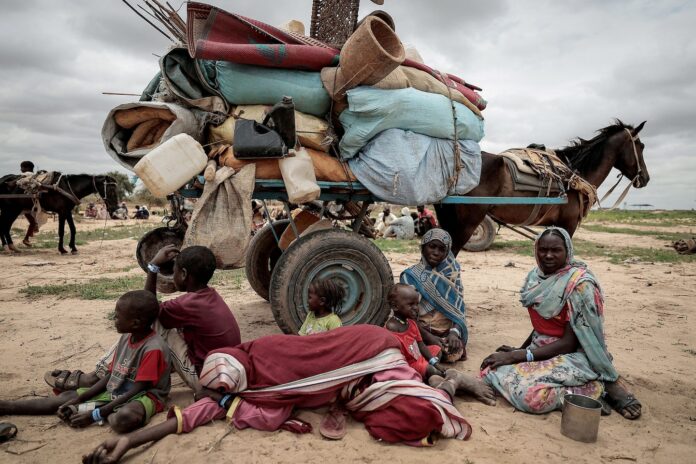“It doesn’t get any worse,” Arif Husain, chief economist for the United Nations World Food Program, told reporters. “I have never seen something at the scale that is happening in Gaza. And at this speed.”
While these two wars consumed the attention of major global news outlets (and this daily newsletter) for much of 2023, other crises smoldered on. In Sudan and Myanmar, ruinous civil wars, marked by myriad atrocities and reports of war crimes, are collapsing already dysfunctional states and provoking spiraling humanitarian crises. Over a wide swath of sub-Saharan Africa, coups and power grabs roiled the region. Social instability and post-pandemic economic pressures fueled surges in migration across the world.
2023 will probably be the hottest year on record, with heat waves scourging every continent, accompanied by other extreme climactic events. Droughts and floods were both more acute — the most viscerally shocking moment came arguably in September, when heavy rains led to the failure of dams and flash floods that killed more than 11,000 in northeastern Libya. “This disaster is of mythic proportions,” a Libyan health official told my colleagues at the time.
In the face of such calamity, one would hope that the new year would bring better news. But, as your humble harbinger of bad tidings, I have to apologize: There’s a lot that can go wrong in 2024, and many crises that will get worse.
The war in Gaza is reaching a dangerous tipping point. While Israeli officials vow a long campaign, the current fighting is pushing Gaza’s 2.2 million people to the brink. The territory is the deadliest place in the world to be a civilian. Before Oct. 7, when the militant group Hamas launched its strike on southern Israel, 80 percent of Gaza’s population required humanitarian assistance. Now, everyone does, and barely a trickle of what’s needed is getting into the besieged territory. Aid organizations and myriad world leaders are calling for a cease-fire and a surge of relief aid into Gaza. But absent a cessation of hostilities, the war could convulse the region, bringing in anti-Israel factions based in Lebanon and Syria, and spawning an unprecedented flow of Palestinian refugees into Egypt.
In its annual “emergency watchlist” published this month, the International Rescue Committee ranked the conflict in Israel and the occupied Palestinian territories as the second most glaring crisis to watch in 2024. The first was the far-less-discussed civil war in Sudan, where eight months of fighting between the country’s military and the paramilitary Rapid Support Forces have left more than half the country in need of humanitarian aid and forced some 6 million people from their homes. Some 19 million children are without education as the conflict has shuttered thousands of schools.
“Sudan has become the world’s largest displacement crisis,” the IRC’s Elshafie Mohamed Ahmed said in the report. “The ability to deliver aid is hindered by the lack of humanitarian access and funds. The ethnic, tribal and regional polarization of the current war is further threatening the limited access currently available.”
150,000.
That’s the number of children forcibly displaced in less than a week as fighting escalates in Sudan’s Al Jazirah state.
Nearly 3M children are at risk.
Here’s what you need to know about this crisis.
— UNICEF (@UNICEF) December 21, 2023
Africa is home to the bulk of the other potential hot spots, as listed by the IRC. Three “coup belt” nations in West Africa — the junta-led states of Burkina Faso, Mali and Niger — are all in the rankings. The Burkinabe military is floundering in the face of a surge in Islamist militancy, with renegade factions controlling more than half the country. In Mali and Niger, where similar dynamics are on show, growing food insecurity and the drying up of foreign aid are plunging millions toward greater peril.
The IRC’s 10 “watchlist” nations account for 86 percent of all people in humanitarian need globally. Lurking behind the political instability consuming these societies is the specter of a warming planet, as droughts and other climate shocks affect some of the world’s most vulnerable communities. “What were once separate circles of crisis are now a Venn diagram with an expanding intersection,” wrote IRC President David Miliband. “Three decades ago, 44% of conflicts happened in climate-vulnerable states. Now that figure is 67%.”
The Biden administration has most successfully held the line in shoring up Western support for Ukraine’s resistance to Russian aggression. But its scope for action will be constrained in a divisive election year, and even Washington’s capacity to fund Kyiv is in doubt — let alone its ability to get its arms around myriad crises elsewhere, from Somalia to Afghanistan to gang-dominated Haiti, teetering on the verge of state collapse.
In Asia, an election in Taiwan may be marked by new provocations from China at a time when the Biden administration is trying to bring some stability to its relationship with Beijing. But the biggest conflagration could take place in Myanmar, where the ruling junta is reeling from an offensive launched by a coalition of rebel militias and seeing mounting desertion in its ranks.
The current trajectory, however, “does not point towards a near-term regime collapse on the battlefield, absent unforeseen developments,” noted Morgan Michaels, a research fellow at the International Institute for Strategic Studies. “Myanmar is instead headed towards a new phase of the conflict, marked by a weakened but still dangerous regime, more intense violence and greater uncertainty.”



